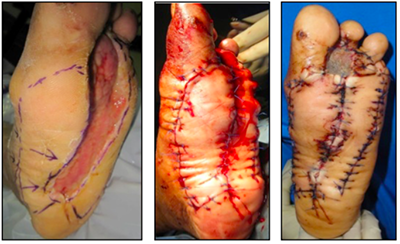Random Perforator Flap : Some Experiences with Keystone Flap
DOI:
https://doi.org/10.14228/jpr.v2i2.158Abstract
Background: In reconstructing challenging defects, surgeons are considered fairly fortunate when they are able to obtain a similar donor tissue quality to that of the missing tissue; in regards to their color, texture, size, and the ease of donor transfer to the defect. Several methods may be used, which frequently include the free tissue transfers using microvascular anastomoses bearing their specific consequences. We report a select of challenging cases which were successfully reconstructed using the Keystone flaps and avoid microvascular anastomoses, where otherwise the free tissue transfers would be the typical option for closure in such defects.
Patient and Method: Nine cases of relatively large defect in various locations were reconstructed using the Keystone flaps supplied by either non-identified perforators or identified reliable perforators.
Result: Out of the 9 defects located on various region of the body (lumbar, thorax, dorsum of the foot, plantar of the foot, posterior leg, sacrum, and cervicofacial) only the first 2 cases had identifiable perforators. All flaps survived completely without problem of vascularization.
Summary: The Keystone flap is a useful and reliable random perforator-based flap even when the perforator vessels are not identified.

Downloads
Published
Issue
Section
License

This work is licensed under a Creative Commons Attribution-NonCommercial-NoDerivatives 4.0 International License.
Authors retain the copyright of the article and grant Jurnal Plastik Rekonstruksi the right of first publication with the work simultaneously licensed under a Creative Commons Attribution License. Articles opting for open access will be immediately available and permanently free for everyone to read, download and share from the time of publication. All open access articles are published under the terms of the Creative Commons Attribution-Non-commercial-NoDerivatives (CC BY-NC-ND) which allows readers to disseminate and reuse the article, as well as share and reuse of the scientific material. It does not permit commercial exploitation or the creation of derivative works without specific permission.













